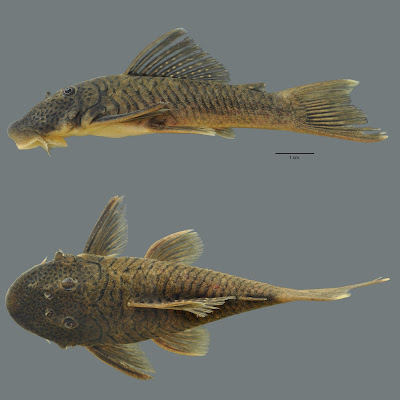 |
| Chaetostoma orientale Meza-Vargas, Calegari, Lujan, Ballen, Oyakawa, Sousa, Rapp Py-Daniel & Reis. 2022 DOI: 10.1643/i2021068 |
Abstract
A new species of the rubbernose pleco genus Chaetostoma is described from the Maicuru and Seiko Rivers, a northern tributary of the lower Amazon River and a tributary of the lower Xingu River, respectively, both in Pará State, Brazil. The new species is diagnosed from all congeners, except members of the Chaetostoma anale species group, by having an enlarged second unbranched anal-fin ray with posterior paired dermal flaps. Additionally, the new species is distinguished from its only other currently recognized congeners from rivers draining the Guiana Shield (C. jegui and C. vasquezi) by having a smaller opercle and a supraoccipital excrescence undeveloped, comprising a simple skin area present in juveniles and absent in adults. A revised multi-locus phylogeny for the species of Chaetostoma is presented, and the Chaetostoma anale species group is discussed and rearranged.
 |
| Chaetostoma orientale, holotype, MCP 54585, male, 132.4 mm SL. Brazil, Pará, Monte Alegre, Maicuru River. |
 |
| Live coloration of Chaetostoma orientale from the Seiko River, shortly after capture. ANSP 199686, photo by Mark Sabaj. facebook.com: Mark Henry Sabaj |
Chaetostoma orientale, new species
Etymology.— The new species is named Chaetostoma orientale, from the Latin orient-, oriens, orientalis, meaning eastern, from the east, of or belonging to the east, in reference to its easternmost distribution among species of the genus. An adjective in neuter form in agreement with genus gender.
 |
| Seiko River, tributary to Jarauçu River, itself a tributary to Xingu River, ca. 3.3 km west of Medicilândia on Trans-Amazon road, .... Photo by Mark Sabaj. facebook.com: Mark Henry Sabaj |
Vanessa Meza-Vargas, Bárbara B. Calegari, Nathan K. Lujan, Gustavo A. Ballen, Osvaldo T. Oyakawa, Leandro M. Sousa, Lúcia Rapp Py-Daniel and Roberto E. Reis. 2022. A New Species of Chaetostoma (Siluriformes: Loricariidae) Expands the Distribution of Rubbernose Plecos Eastward into the Lower Amazon Basin of Brazil. Ichthyology & Herpetology. 110(2); 364-377. DOI: 10.1643/i2021068 (29 June 2022)
Uma nova espécie de Chaetostoma é descrita dos rios Maicuru, um afluente norte do baixo rio Amazonas, e Seiko, um afluente do baixo rio Xingu, ambos no estado do Pará, Brasil. A nova espécie é diagnosticada de todos os seus congêneres, exceto membros do grupo Chaetostoma anale, por apresentar o segundo raio não ramificado da nadadeira anal aumentado e com abas dérmicas posteriores. Além disso, a nova espécie se distingue dos únicos outros congêneres atualmente reconhecidos do Escudo das Guianas (C. jegui e C. vasquezi) por ter o opérculo menor e a protuberância supraoccipital não desenvolvida, composta por uma área de pele simples em juvenis e ausente em adultos. Uma filogenia multilocus revisada para as espécies de Chaetostoma é apresentada e o grupo Chaetostoma anale é discutido e reorganizado.
